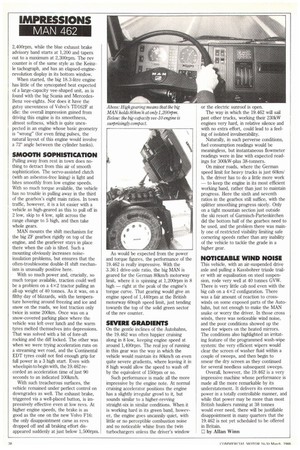SEVERE GRADIENTS
Page 40

If you've noticed an error in this article please click here to report it so we can fix it.
On the gentle inclines of the Autobahns, the 19.462 was often happier cruising along in 8 low, keeping engine speed at around 1,400rpm. The real joy of running in this gear was the way in which the vehicle would maintain its 80km/h on even quite severe gradients, where leaving it in 8 high would allow the speed to wash off by the equivalent of 150rpm or so.
Such performance is made all the more impressive by the engine note. At normal cruising accelerator positions the engine has a slightly irregular growl to it, but sounds similar to a higher-revving straight-six in similar conditions. When it is working hard in its green band, however, the engine goes uncannily quiet, with little or no perceptible combustion noise and no noticeable whine from the twin turbochargers unless the driver's window or the electric sunroof is open.
The way in which the 19.462 will sail past other trucks, working their 230kW engines very hard, in relative silence and with no extra effort, could lead to a feeling of isolated invulnerability.
Naturally, in such perverse conditions, fuel consumption readings would be meaningless, but instantaneous flowineter readings were in line with expected readings for 300kW-plus 38-tanners.
On minor roads, where the German speed limit for heavy trucks is just 60km/ h, the driver has to do a little more work — to keep the engine in its most efficient working band, rather than just to maintain progress. Here the sixth and seventh ratios in the gearbox still suffice, with the splitter smoothing progress nicely. Only on a tight mountain section just outside the ski resort of Garmisch-Partenkirchen did the bottom half of the gearbox need to be used, and the problem there was mainly one of restricted visibility limiting safe cornering speeds rather than any inability of the vehicle to tackle the grade in a higher gear.
















































































































